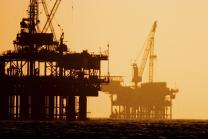US' Versabar develops larger lifting unit for global market
Versabar, the New Orleans-based heavy lifting company, is in preliminary talks with operators to build a larger version of the VB 10,000 heavy lifting catamaran for use in areas outside the Gulf of Mexico, Tom Cheatum, the company’s Marketing Director, told Decom World.

Versabar has started preliminary work on the building of the larger lifting unit and in parallel has developed a method to drastically shorten the process of releasing sea-bed structures.
“We’ve entered into a lot of preliminary talks with operators around the globe because there’s a void of heavy lift capability outside the North Sea and outside the Gulf of Mexico. Areas like Australia, Indonesia, East Asia don't have assets available to do decommissioning,” Cheatum said.
The VB 10,000 is the largest lift vessel ever built in the United States, and performs a single-piece topside retrieval. It was deployed for the first time in 2010.
A new larger version could cost $300 million to build, will only built if there is sufficient demand from operators, and will not be intended for the Gulf of Mexico, Cheatum said.
“We wouldn't take the VB 10,000 out of the Gulf, and if we did take anything [elsewhere], it would be a larger one,” he said.
The VB 10,000 was designed to remove derelict oil rigs in the Gulf of Mexico, particularly those damaged by hurricanes. Demand was driven by the 2010 “idle iron” regulation that required operators to remove non-producing platforms.
Versabar plans to continue marketing the VB 10,000 in the Gulf of Mexico area as the decommissioning market grows.
Pricing heavy lift
While larger lifting vehicles such as VB 10,000 might cost operators three times more than smaller systems on a daily basis, they can present less time-risk, Cheatum adds.
“The first things that someone will say is, ‘what’s the day rate for that system?” he said.
The day rate might be three times greater than when using a conventional method of removing the platform piece by piece, but this is offset by the greater certainty that the work could be finished in a short time.
“That’s the message we have to get across and we have to engage the operators in a transparent negotiation to help them understand. Their experience level is now much higher than it was…The key is a very frank conversation about costs.”
Operators are particularly sensitive about decommissioning costs given there are no production resources rewarded at the end of the process, Cheatum noted.
Cutting edge
If the company does build a successor vessel, it will aim to protect its position in the marketplace by incorporating a number of new engineering techniques that have been tested using the VB 10,000.
These include a revolutionary method of cutting structures that are anchored to the sea bed. Environmental regulations in the Gulf of Mexico require that fixed structures be removed at a depth of 15 feet below the mud line. Using traditional technology this takes somewhere between four days and two weeks, depending on the kinds of problem encountered. Cheatum said Versabar is working on a method of completing the cuts and the lift in a single day.
Versebar’s solution is to fit a cutting wire to its VB 10,000 heavy lift vessel, and deploy it using a 1,300 tonne lift frame that can anchor the wire saw against the structure to be cut and accommodate the winches that move it back and forth. Cheatum said that when this was tested in field conditions, using a 250-tonne caisson-mounted topside in April 2014, it was shown to work.
“Our first issue was learning how to get through the mud – that took us six hours – once we’d done that it took fours hours to make the cut. So, 10 hours and it was lifted and gone.”
Refinements
Versabar has been working onshore to refine this cutting method, improving the tungsten cutting rods that are welded onto the metal sleeves and attached to a wire rope.
Versabar plans to develop the wire cutting technique into a commercial system that can take out much larger platform systems and conductors.
“It took some testing to determine exactly what was the best configuration for the sleeves. When you get into larger systems you have multiple wells coming in and so you have multiple conductors, so getting through the outside legs is not really a large issue. What is important is getting through these conductor systems because there are a lot of things that will cut metal and a lot of things that will cut cement, but we needed to cut metal and then cut cement,” Cheatum said.
Versabar is now refining the prototype so that it is lighter and the winches are tuned quicker.
An increasing number of platform contractors are moving into the decommissioning space.
In the Gulf of Mexico alone, the market size of decommissioning was valued at $26 billion in January 2015, according to Decom World’s Offshore Decommissioning Report 2015.
The market size of the shallow water segment is estimated at $18 billion and deepwater projects represent $8 billion, the report showed.
